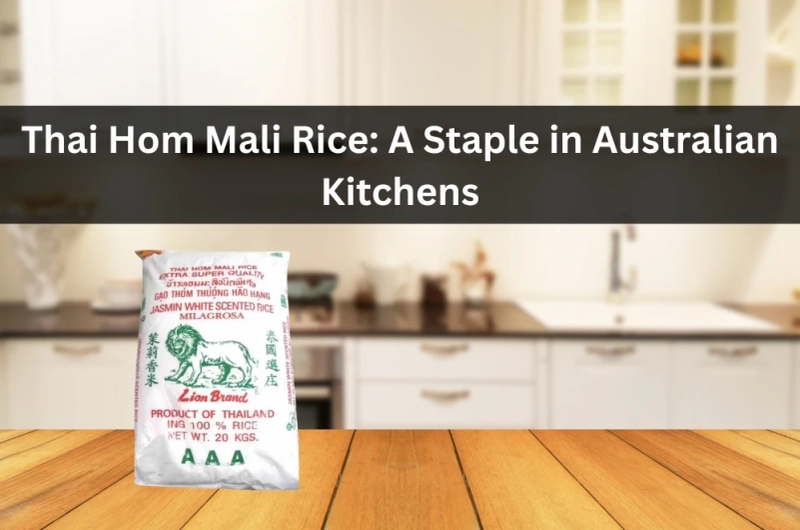Ask any Thai cook what anchors a meal, and they’ll point to a fragrant bowl of steamed grains. In Australia, the shift from generic long-grain to origin-true jasmine is more than a trend; it’s a move toward traceable quality. If you’re buying for home or hospitality, begin with authentic thai jasmine rice and build your cooking and procurement choices around aroma, grain integrity, and reliable supply.
What sets Thai Hom Mali apart
Not all “jasmine” is equal. Hom Mali is a protected Thai variety known for perfume and soft, separate grains.
- Signature aroma: the natural 2-AP compound delivers that pandan-like scent.
- Tender texture: cohesive but fluffy — no gluey clumps when cooked with care.
- Origin controls: Thai standards govern purity and export grading.
- Kitchen range: perfect for steamed sides, fried rice, and coconut-based curries.
Once you taste a fresh-crop Hom Mali, your baseline changes; it’s hard to go back.
Understanding quality and standards
Labels promise a lot; only some deliver. It’s worth reading for vintage, milling, and compliance. For a broader view of local production and policy settings that influence availability, see Australian rice industry standards.
- Grading clarity: seek purity percentages and harvest year.
- Moisture control: well-milled rice cooks evenly and fluffs reliably.
- Aroma retention: oxygen-barrier packaging preserves fragrance longer.
- Import compliance: quarantine and labelling protect quality and safety.
A little label literacy pays off in the bowl.
Cooking technique for aroma and texture
You don’t need gadgets. A saucepan and good habits do the job.
- Rinse with intent: two to three gentle rinses; keep some surface starch.
- Water ratio: 1:1.1–1.2 by volume for fresh crop; a touch more for older lots.
- No-peek rest: lid on, heat off for 10 minutes to finish steaming.
- Fluff lightly: use a fork or paddle; don’t mash the grains.
In my kitchen, the quiet rest is the difference between good and great.
Pairing with Australian produce
Hom Mali’s subtle sweetness flatters local ingredients.
- Seafood harmony: pairs with snapper, prawns, or scallops without overpowering.
- Citrus lifts: finger lime or lemon myrtle adds a bright, clean finish.
- Heat balance: carries chilli while keeping aromatics centre stage.
- Weeknight workhorse: batch-cook and chill for next-day fried rice.
It’s the dinner staple that makes the rest of the plate sing.
Buying smart for home and hospitality
Consistency steadies service and saves money.
- Right pack size: fresher intake beats sitting on an oversized bag.
- Lot tracking: note milling dates; rotate stock first-in, first-out.
- Storage discipline: cool, dark cupboard; reseal between uses.
- Supplier dialogue: ask about seasonality and shipment cycles.
Good suppliers welcome questions. Vague answers are a red flag.
Skill-building at home
Technique beats gadgets nine times out of ten. If you’re levelling up, a guide on mastering Asian home cooking helps you dial heat, seasoning, and timing so rice plays nicely with everything else.
- Starch choreography: match wok heat to rice dryness for crisp fried rice.
- Salt vs umami: balance fish sauce and soy; they’re not interchangeable.
- Herb timing: basil and coriander lose perfume if added too early.
- Leftover magic: day-old rice transforms into texture-rich stir-fries.
Small habits compound into confident cooking.
A service-night anecdote
At a pop-up in Sydney’s inner west, we swapped to a new Hom Mali lot mid-run. Same spec, different harvest. The first pot ran soft. Fix? Reduce water by a tablespoon per cup and extend the rest. Service steadied, aroma snapped back, plates came home clean. Tiny adjustments, big outcome.
Sourcing for consistency (and value)
If you’re feeding a crowd — family or small venue — scale without sacrificing quality.
- Pilot small: test a 5 kg bag before graduating to a 10–20 kg format.
- Blend cautiously: mixing lots can stabilise texture, but note ratios.
- Menu match: pair rice format to dishes — fragrant steamed vs day-old fried.
- Waste watch: pre-measure to cut leftovers; repurpose chilled ricethe next day.
Scaling well is just good planning with numbers and notes.
How to spot genuine Hom Mali rice on Australian shelves
Labels can blur lines; genuine Hom Mali has tell-tale signs. A minute of checking saves months of mediocre meals.
- Origin statements: look for “Product of Thailand” with clear region or certification language.
- Crop year: fresher harvests hold aroma better; seek a stated vintage or milling date.
- Purity indicators: terms like “100% Thai Hom Mali” or variety codes beat vague “jasmine-style” claims.
- Packaging quality: intact seals and oxygen-barrier bags protect fragrance and texture.
When the label is specific, the cooking is predictable. If details are vague, assume blended or old stock and adjust expectations.
Batch cooking and storage tips for consistent restaurant results
Whether you’re feeding a family or doing small service, stable processes tame the rush. Consistency comes from ratios, timing, and cooling discipline.
- Measured ratios: standardise water-to-rice and log tweaks by lot to remove guesswork.
- Steam rest: build in a 10–15 minute rest after heat-off for even moisture distribution.
- Rapid chill: tray out hot rice in thin layers and cool quickly to keep grains separate.
- Reheat method: re-steam with a splash of water or use high heat in the wok for fried rice.
Write the method once and stick to it. Your future self — or the weekend staffer — will thank you.
The practical wrap-up
Good jasmine rice isn’t a luxury; it’s the quiet centre of the plate. Start with an origin-true supplier, check harvest details, and treat the grain gently from storage to simmer. Build small rituals — measured rinses, precise ratios, that crucial resting period — and you’ll get reliable results whether it’s Tuesday dinner or a 60-cover night. If you’re provisioning for larger households or hospitality, look into procurement considerations for bulk jasmine rice so cost, consistency, and quality line up for the long term.


